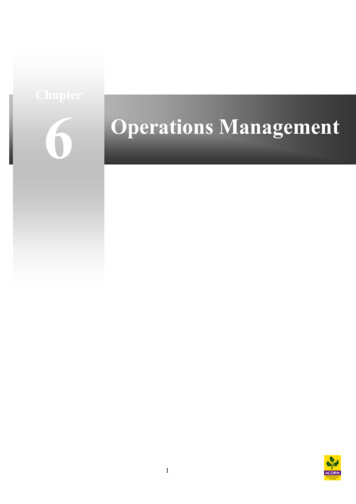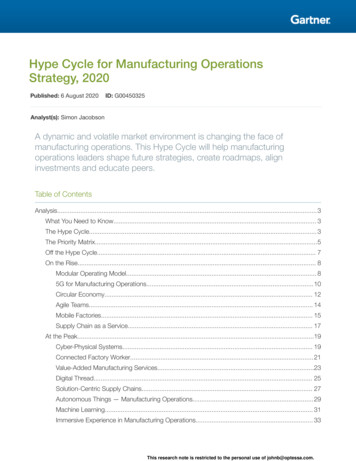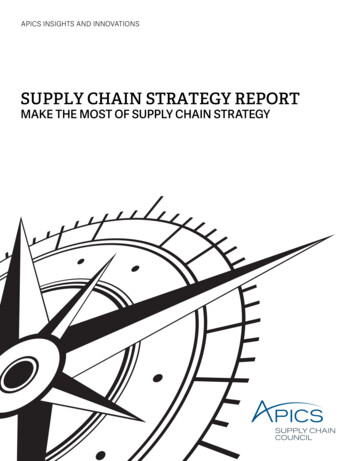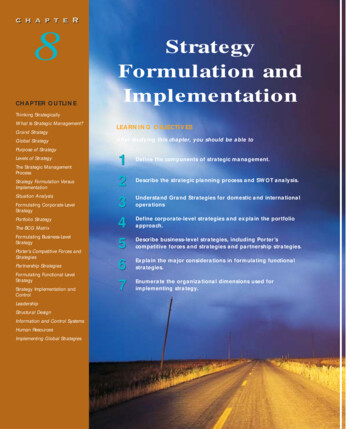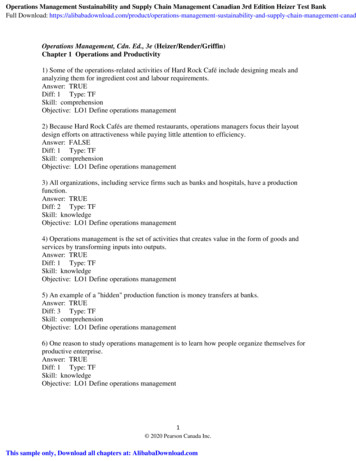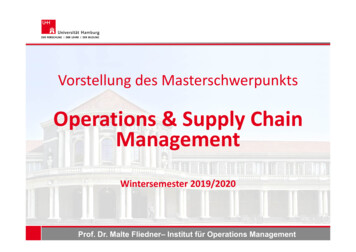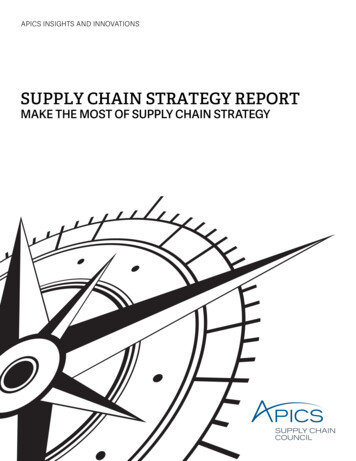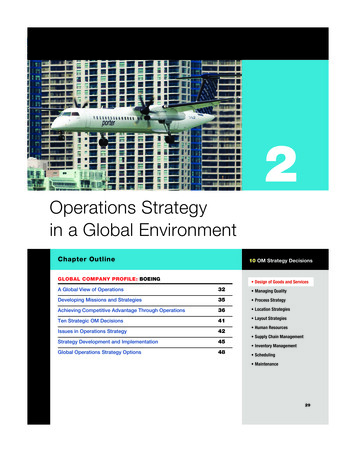
Transcription
2Operations Strategyin a Global EnvironmentChapter Outline10 OM Strategy DecisionsGLOBAL COMPANY PROFILE: BOEING Design of Goods and ServicesA Global View of Operations32 Managing QualityDeveloping Missions and Strategies35 Process StrategyAchieving Competitive Advantage Through Operations36 Location StrategiesTen Strategic OM Decisions41 Layout StrategiesIssues in Operations Strategy42Strategy Development and Implementation45Global Operations Strategy Options48 Human Resources Supply Chain Management Inventory Management Scheduling Maintenance2902 ch02 heiz.indd 299/25/12 7:05 PM
GLOBAL COMPANY PROFILEBOEINGBoeing’s Global Strategy Yields Competitive AdvantageBoeing’s strategy for its 787 Dreamliner is uniquefrom both an engineering and global perspective.The Dreamliner incorporates the latest in a widerange of aerospace technologies, from airframe andengine design to superlightweight titanium graphitelaminate, carbon fibre and epoxy, and composites.Another innovation is the electronic monitoring systemthat allows the airplane to report maintenance requirements to ground-based computer systems. Boeing hasalso worked with General Electric and Rolls-Royce todevelop more efficient engines. The advances in enginetechnology contribute as much as 8% of the increasedfuel/payload efficiency of the new airplane, representingBoeing’s collaborative technology enables a “virtual workspace” that allowsengineers on the 787, including partners in Australia, Japan, Italy, Canada,and across the United States, to make concurrent design changes to theairplane in real time. Designing, building, and testing the 787 digitally beforeproduction reduced design errors and improved production efficiencies.a nearly two-generation jump in technology.Some of the International Suppliers of Boeing 787 ComponentsLatecoereFrancePassenger doorsLabinelFranceWiringDassaultFranceDesign and PLM softwareMessier-BugattiFranceElectric brakesThalesFranceElectrical power conversionsystem and integratedstandby flight displayThis state-of-the-art Boeing 787 is also global.Led by Boeing at its Everett, Washington facility, aninternational team of aerospace companies developed the airplane. New technologies, new design,new manufacturing processes, and committed international suppliers are helping Boeing and its partnersachieve unprecedented levels of performance inMessier-DowtyFranceLanding gear structureDiehlGermanyInterior lightingCobhamUKFuel pumps and valvesRolls-RoyceUKEnginesof 13 800 km but also because it is built all over thedesign, manufacture, and operation.The 787 is global not only because it has a rangeSmiths AerospaceUKCentral computer systemworld—with a huge financial risk of over 5 billionBAE SystemsUKElectronics(USD), Boeing needed partners. The global nature ofAlenia AeronauticaItalyUpper centre fuselageand horizontal stabilizerboth technology and the aircraft market meant findingToray IndustriesJapanCarbon fibre for wing and tailmight be. It also meant finding firms willing to step upunitsexceptional developers and suppliers, wherever theyFuji Heavy Industries JapanCentre wing boxto the risk associated with a very expensive new prod-Kawasaki HeavyIndustriesJapanForward fuselage, fixedsections of wing, landinggear wheel welluct. These partners not only spread the risk but alsoTeijin SeikiJapanHydraulic actuatorsa stake in the 787 are more likely to buy from BoeingMitsubishi HeavyIndustriesJapanWing boxthan from the European competitor Airbus Industries.Chengdu AircraftGroupChinaRudderHafei AviationChinaPartsdesign concepts for the 787. Boeing found its 787Korean AirlinesSouth KoreaWingtipspartners in over a dozen countries; a few of them areSaabSwedenCargo and access doorsshown in the table on the left.bring commitment to the table. Countries that haveBoeing teamed with more than 20 internationalsystems suppliers to develop technologies and3002 ch02 heiz.indd 309/25/12 7:05 PM
Chapter 2 Operations Strategy in a Global Environment 31Components from Boeing’s worldwide supply chain come together on anassembly line in Everett, Washington. Although components come fromthroughout the world, about 35% of the 787 structure comes from Japanesecompanies.State-of-the-art composite sections of the 787 are built around the world and shippedto Boeing for final assembly.Dreamliner built by other companies. And even someThe Japanese companies Toray, Teijin Seiki,Fuji, Kawasaki, and Mitsubishi are producing overof the portion built by Boeing is produced at Boeing35% of the project, providing whole compositefacilities outside the United States, in Australia andfuselage sections. Italy’s Alenia Aeronautica isCanada.The global Dreamliner is efficient, has a globalbuilding an additional 10% of the plane.range, and is made from components producedMany U.S. companies, including CraneAerospace, Fairchild Controls, Goodrich, Generalaround the world. The result: a state-of-the-artDynamics, Hamilton Sundstrand, Honeywell, Moog,airplane reflecting the global nature of business inParker Hannifin, Rockwell Collins, and Triumph Groupthe 21st century and one of the fastest-sellingare also suppliers. Boeing has 70% to 80% of thecommercial jets in history.Chapter 2 Learning ObjectivesLO1: Define mission and strategyLO2: Identify and explain three strategicapproaches to competitive advantageLO3: Identify and define the 10 decisionsof operations management02 ch02 heiz.indd 313636LO4: Understand the significance of key successfactors and core competencies45LO5: Identify and explain four global operationsstrategy options48419/25/12 7:05 PM
32PART 1Introduction to Operations ManagementAUTHOR COMMENTAs Prof. Thomas Sewellobserved, “No greatcivilization has developedin isolation.”A Global View of OperationsToday’s operations manager must have a global view of operations strategy. Since the early1990s, nearly 3 billion people in developing countries have overcome the cultural, religious,ethnic, and political barriers that constrain productivity and are now players on the global economic stage. As these barriers disappear, simultaneous advances are being made in technology,reliable shipping, and cheap communication. The unsurprising result is the growth of world trade(see Figure 2.1), global capital markets, and the international movement of people. This meansincreasing economic integration and interdependence of countries—in a word, globalization. Inresponse, organizations are hastily extending their operations globally with innovative strategies.For instance: Boeing is competitive because both its sales and production are worldwide. Italy’s Benetton moves inventory to stores around the world faster than its competition bybuilding flexibility into design, production, and distribution. Sony purchases components from suppliers in Thailand, Malaysia, and elsewhere around theworld for assembly in its electronic products. Volvo, considered a Swedish company, was recently controlled by a U.S. company (Ford)and has been subsequently acquired by Geely of China. But the current Volvo S40 is built inBelgium on a platform shared with the Mazda 3 (built in Japan) and the Ford Focus (built andsold in Europe.)Globalization means that domestic production and exporting may no longer be a viable businessmodel; local production and exporting no longer guarantee success or even survival. There arenew standards of global competitiveness that impact quality, variety, customization, convenience, timeliness, and cost. The globalization of strategy contributes efficiency and adds valueto products and services, but it also complicates the operations manager’s job. Complexity, risk,and competition are intensified; companies must carefully account for them.We have identified six reasons why domestic business operations decide to change to someform of international operation. They are:1.2.3.4.5.6.Reduce costs (labour, taxes, tariffs, etc.).Improve the supply chain.Provide better goods and services.Understand markets.Learn to improve operations.Attract and retain global talent.Let us examine, in turn, each of the six reasons.Many international operations seek to take advantage of the tangible opportunities to reduce their costs. Foreign locations with lower wages can help lower both directand indirect costs. (See the OM in Action box “Cartoon Production at Home in Manila.”) Lessstringent government regulations on a wide variety of operation practices (e.g., environmentalREDUCE COSTS FIGURE 2.1Growth of World Trade(world trade as apercentage of world GDP)30*Author estimate for 2010.25PercentSource: Growth of World Trade basedon a speech by Mark A. Wynne, FederalReserve Bank of Dallas, June 2009.35Collapse of theBerlin Wall201510501960 196502 ch02 heiz.indd 3219701975 19801985 1990Year199520002005 2010 (est.*)9/25/12 7:05 PM
Chapter 2 Operations Strategy in a Global Environment 33control, health and safety, etc.) reduce costs. Opportunities to cut the cost of taxes and tariffs alsoencourage foreign operations. In Mexico, the creation of maquiladoras (free trade zones) allowsmanufacturers to cut their costs of taxation by paying only on the value added by Mexican workers. If a Canadian manufacturer brings a 500 machine to a maquiladora operation for assemblywork costing 25, tariff duties will be charged only on the 25 of work performed in Mexico.Shifting low-skilled jobs to another country has several potential advantages. First, and mostobviously, the firm may reduce costs. Second, moving the lower skilled jobs to a lower costlocation frees higher cost workers for more valuable tasks. Third, reducing wage costs allows thesavings to be invested in improved products and facilities (and the retraining of existing workers,if necessary) at the home location. The impact of this approach is shown in the OM in Action box“Going Global to Compete” on the next page.Trade agreements have also helped reduce tariffs and thereby reduce the cost of operatingfacilities in foreign countries. The World Trade Organization (WTO) has helped reducetariffs from 40% in 1940 to less than 3% today. Another important trade agreement is theNorth American Free Trade Agreement (NAFTA). NAFTA seeks to phase out all trade andtariff barriers among Canada, Mexico, and the U.S. Other trade agreements that are acceleratingglobal trade include APEC (the Pacific Rim countries), SEATO (Australia, New Zealand, Japan,Hong Kong, South Korea, New Guinea, and Chile), MERCOSUR (Argentina, Brazil, Paraguay,and Uruguay), and CAFTA (Central America, Dominican Republic, and United States).Another trading group is the European Union (EU).1 The European Union has reduced tradebarriers among the participating European nations through standardization and a common currency, the euro. However, this major Canadian trading partner, with almost 500 million people, is also placing some of the world’s most restrictive conditions on products sold in the EU.Everything from recycling standards to automobile bumpers to hormone-free farm productsmust meet EU standards, complicating international trade.MaquiladorasMexican factories located alongthe U.S.–Mexico border thatreceive preferential tarifftreatment.World Trade Organization (WTO)An international organization thatpromotes world trade by loweringbarriers to the free flow of goodsacross borders.NAFTAA free trade agreement betweenCanada, Mexico, and the UnitedStates.European Union (EU)A European trade group that has27 member states.The supply chain can often be improved by locating facilities incountries where unique resources are available. These resources may be expertise, labour, orraw material. For example, a trend is evident in which precious metals companies are relocatingto the mining regions of Northern Ontario. Auto-styling studios from throughout the world aremigrating to the auto mecca of southern California to ensure the necessary expertise in contemporary auto design. Similarly, world athletic shoe production has migrated from South Korea toGuangzhou, China: this location takes advantage of the low-cost labour and production competence in a city where 40 000 people work making athletic shoes for the world. And a perfumeessence manufacturer wants a presence in Grasse, France, where much of the world’s perfumeessences are prepared from the flowers of the Mediterranean.IMPROVE THE SUPPLY CHAINOM in Action Cartoon Production at Home in ManilaFred Flintstone is not from Bedrock. He is actually fromManila, capital of the Philippines. So are Tom and Jerry,Aladdin, and Donald Duck. More than 90% of NorthAmerican television cartoons are produced in Asia andIndia, with the Philippines leading the way. With theircompetitive advantage of English as an official languageand a strong familiarity with North American culture,animation companies in Manila now employ more than1700 people. Filipinos understand Western culture, and“you need to have a group of artists that can understandthe humour that goes with it,” says Bill Dennis, a HannaBarbera executive.Major studios like Disney, Marvel, Warner Brothers,and Hanna-Barbera send storyboards—cartoon actionoutlines—and voice tracks to the Philippines. Artiststhere draw, paint, and film about 20,000 sketches for a30-minute episode. The cost of 130 000 to produce anepisode in the Philippines compares with 160 000 inKorea and 500 000 in the United States.Sources: Journal of Global Information Technology Management (2007):1–6; The New York Times (February 26, 2004): A29; and The Wall StreetJournal (August 9, 2005): D8.1The27 members of the European Union (EU) as of 2010 were Austria, Belgium, Bulgaria, Cyprus, Czech Republic,Denmark, Estonia, Finland, France, Germany, Greece, Hungary, Ireland, Italy, Latvia, Lithuania, Luxembourg, Malta,the Netherlands, Poland, Portugal, Romania, Slovakia, Slovenia, Spain, Sweden, United Kingdom. Not all haveadopted the euro. In addition, Croatia, Macedonia, and Turkey are candidates for entry into the European Union.02 ch02 heiz.indd 339/25/12 7:05 PM
34PART 1Introduction to Operations ManagementOM in Action Going Global to CompeteHeadquartered in Montreal and founded in 1880, BellCanada is one of Canada’s prominent players in wireless telecommunications, controlling about 30% of thedomestic market. Approximately 50% of Bell Canada’srevenue stems from its wireless initiatives. It is activein contracting suitable vendors as part of outsourcingkey voice-based projects for its satellite TV, Bell Mobility, Solo Mobility, and internet divisions. Bell Canadaintends to outsource these particular projects via fixedpayouts as part of a deal worth roughly between 25and 30 million (CAD) per year. India is the beneficiaryof these outsourced contracts, and the projects includeinbound customer contact. Bell remains watchful foroutsourcing partners with strong competencies inmanaging this type of front-end work.In a similar fashion, the Canadian Bar Association reported through its in-house magazine about the“commoditization” of legal services, and noted a trendtowards outsourcing certain aspects of legal work.Although the concept is fairly new to Canadian lawyers,firms that do engage in it suggest they provide hourlysavings of up to 75%.Resourceful organizations, such as Bell Canadaand these certain law firms, use a global perspective tobecome more efficient, which allows them to developnew products, retrain employees, and invest in new plantand equipment.Sources: aspx andwww.bell.caPROVIDE BETTER GOODS AND SERVICES Although the characteristics of goods and services canbe objective and measurable (e.g., number of on-time deliveries), they can also be subjective andless measurable (e.g., sensitivity to culture). We need an ever better understanding of differencesin culture and of the way business is handled in different countries. Improved understanding asthe result of a local presence permits firms to customize products and services to meet uniquecultural needs in foreign markets.Another reason to have international operations is to reduce response time to meet customers’changing product and service requirements. Customers who purchase goods and services fromCanadian firms are increasingly located in foreign countries. Providing them with quick andadequate service is often improved by locating facilities in their home countries.Because international operations require interaction with foreign customers, suppliers, and other competitive businesses, international firms inevitably learn aboutopportunities for new products and services. Europe led the way with cell phone innovations,and now the Japanese lead with the latest cell phone fads. Knowledge of these markets not onlyhelps firms understand where the market is going but also helps firms diversify their customerbase, add production flexibility, and smooth the business cycle.UNDERSTAND MARKETSA worldwide strategy places added burdens on operationsmanagement. Because of economic and lifestyle differences, designers must target products to each market. Forinstance, clothes washers sold in northern countries mustspin-dry clothes much better than those in warmer climates,where consumers are likely to line-dry them. Similarly, asshown here, Whirlpool refrigerators sold in Bangkok aremanufactured in bright colours because they are often putin living rooms.02 ch02 heiz.indd 349/25/12 7:05 PM
Chapter 2 Operations Strategy in a Global Environment 35Another reason to go into foreign markets is the opportunity to expand the life cycle (i.e.,stages a product goes through; see Chapter 5) of an existing product. While some products inCanada are in a “mature” stage of their product life cycle, they may represent state-of-the-artproducts in less developed countries. For example, the Canadian market for personal computerscould be characterized as “mature” but as in the “introductory” stage in many developing countries, such as Albania, Vietnam, and Myanmar (Burma).LEARN TO IMPROVE OPERATIONS Learning does not take place in isolation. Firms serve themselves and their customers well when they remain open to the free flow of ideas. For example,GM found that it could improve operations by jointly building and running, with the Japanese,an auto assembly plant in San Jose, California. This strategy allowed GM to contribute its capitaland knowledge of North American labour and environmental laws while the Japanese contributed production and inventory ideas. Similarly, operations managers have improved equipmentand layout by learning from the ergonomic competence of the Scandinavians.Global organizations can attract and retain betteremployees by offering more employment opportunities. They need people in all functional areasand areas of expertise worldwide. Global firms can recruit and retain good employees becausethey provide both greater growth opportunities and insulation against unemployment duringtimes of economic downturn. During economic downturns in one country or continent, a globalfirm has the means to relocate unneeded personnel to more prosperous locations.So, to recap, successfully achieving a competitive advantage in our shrinking world meansmaximizing all of the possible opportunities, from tangible to intangible, that international operations can offer.ATTRACT AND RETAIN GLOBAL TALENTCULTURAL AND ETHICAL ISSUESWhile there are great forces driving firms toward globalization, many challenges remain. Oneof these challenges is reconciling differences in social and cultural behaviour. With issues ranging from bribery, to child labour, to the environment, managers sometimes do not know how torespond when operating in a different culture. What one country’s culture deems acceptable maybe considered unacceptable or illegal in another. It is not by chance that there are fewer femalemanagers in the Middle East than in India.In the last decade, changes in international laws, agreements, and codes of conduct have beenapplied to define ethical behaviour among managers around the world. The WTO, for example,helps to make uniform the protection of both governments and industries from foreign firmsthat engage in unethical conduct. Even on issues where significant differences between culturesexist, as in the area of bribery or the protection of intellectual property, global uniformity isslowly being accepted by most nations.In spite of cultural and ethical differences, we live in a period of extraordinary mobility ofcapital, information, goods, and even people. We can expect this to continue. The financial sector, the telecommunications sector, and the logistics infrastructure of the world are healthy institutions that foster efficient and effective use of capital, information, and goods. Globalization,with all its opportunities and risks, is here and will continue. It must be embraced as managersdevelop their missions and strategies.Developing Missions And StrategiesAn effective operations management effort must have a mission so it knows where it is going anda strategy so it knows how to get there. This is the case for a small domestic organization, as wellas a large international organization.AUTHOR COMMENTAs the owner of a Guatemalaplant said, “The ethics ofthe world markets is veryclear: Manufacturers willmove wherever it is cheapestor most convenient to theirinterests.”AUTHOR COMMENTGetting an education andmanaging an organizationboth require a mission andstrategy.MISSIONEconomic success, indeed survival, is the result of identifying missions to satisfy a customer’sneeds and wants. We define the organization’s mission as its purpose—what it will contributeto society. Mission statements provide boundaries and focus for organizations and the conceptaround which the firm can rally. The mission states the rationale for the organization’s existence.02 ch02 heiz.indd 35MissionThe purpose or rationale for anorganization’s existence.9/25/12 7:05 PM
36PART 1Introduction to Operations Management FIGURE 2.2Mission Statements forThree OrganizationsSources: Annual reports: courtesyof Royal Canadian Mounted Police,Hard Rock Cafe: EmployeeHandbook, Arnold Palmer Childrens’Care Team.Royal Canadian Mounted PoliceThe RCMP is Canada's national police service. Proud of our traditions and confident inmeeting future challenges, we commit to preserve the peace, uphold the law and providequality service in partnership with our communities.Hard Rock CafeNOTE: The missionstatement has been editedas per Julie's email.Our Mission: To spread the spirit of rock 'n roll by creating authentic experiences that rock.Arnold Palmer HospitalArnold Palmer Hospital for Children provides state of the art, family-centered healthcarefocused on restoring the joy of childhood in an environment of compassion, healing and hope.LO1: Define mission and strategyDeveloping a good strategy is difficult, but it is much easier if the mission has been well defined.Figure 2.2 provides examples of mission statements.Once an organization’s mission has been decided, each functional area within the firm determines its supporting mission. By functional area we mean the major disciplines required by thefirm, such as marketing, finance/accounting, and production/operations. Missions for each function are developed to support the firm’s overall mission. Then within that function lower-levelsupporting missions are established for the OM functions. Figure 2.3 provides such a hierarchyof sample missions.STRATEGYStrategyHow an organization expects toachieve its missions and goals.LO2: Identify and explainthree strategic approaches tocompetitive advantageVIDEO 2.1Operations Strategy at Regal MarineAUTHOR COMMENTFor many organizations, theoperations function providesthe competitive advantage.Competitive advantageThe creation of a uniqueadvantage over competitors.02 ch02 heiz.indd 36With the mission established, strategy and its implementation can begin. Strategy is an organization’s action plan to achieve the mission. Each functional area has a strategy for achievingits mission and for helping the organization reach the overall mission. These strategies exploitopportunities and strengths, neutralize threats, and avoid weaknesses. In the following sections,we will describe how strategies are developed and implemented.Firms achieve missions in three conceptual ways: (1) differentiation, (2) cost leadership,and (3) response. This means operations managers are called on to deliver goods and services that are (1) better, or at least different, (2) cheaper, and (3) more responsive. Operationsmanagers translate these strategic concepts into tangible tasks to be accomplished. Any one orcombination of these three strategic concepts can generate a system that has a unique advantage over competitors. For example, Hunter Fan has differentiated itself as a premier maker ofquality ceiling fans that lower heating and cooling costs for its customers. Nucor Steel, on theother hand, satisfies customers by being the lowest-cost steel producer in the world. And Dellachieves rapid response by building personal computers with each customer’s requested software in a matter of hours.Clearly, strategies differ. And each strategy puts different demands on operations management. Hunter Fan’s strategy is one of differentiating itself via quality from others in the industry.Nucor focuses on value at low cost, and Dell’s dominant strategy is quick, reliable response.Achieving Competitive AdvantageThrough OperationsEach of the three strategies provides an opportunity for operations managers to achieve competitive advantage. Competitive advantage implies the creation of a system that has a uniqueadvantage over competitors. The idea is to create customer value in an efficient and sustainableway. Pure forms of these strategies may exist, but operations managers will more likely be called9/25/12 7:05 PM
Chapter 2 Operations Strategy in a Global Environment 37Sample Company MissionTo manufacture and service an innovative, growing, and profitable worldwide microwavecommunications business that exceeds our customers’ expectations. FIGURE 2.3Sample Missions for aCompany, the OperationsFunction, and Major OMDepartmentsSample Operations Management MissionTo produce products consistent with the company’s mission as the worldwide low-costmanufacturer.Sample OM Department MissionsProduct designTo design and produce products and services with outstandingquality and inherent customer value.Quality managementTo attain the exceptional value that is consistent with ourcompany mission and marketing objectives by closeattention to design, procurement, production, and fieldservice opportunities.Process designTo determine, design, and produce the production processand equipment that will be compatible with low-cost product,high quality, and a good quality of work life at economical cost.LocationTo locate, design, and build efficient and economical facilitiesthat will yield high value to the company, its employees, andthe community.Layout designTo achieve, through skill, imagination, and resourcefulness inlayout and work methods, production effectiveness andefficiency while supporting a high quality of work life.Human resourcesTo provide a good quality of work life, with well-designed, safe,rewarding jobs, stable employment, and equitable pay, inexchange for outstanding individual contribution fromemployees at all levels.Supply-chain managementTo collaborate with suppliers to develop innovative productsfrom stable, effective, and efficient sources of supply.InventoryTo achieve low investment in inventory consistent with highcustomer service levels and high facility utilization.SchedulingTo achieve high levels of throughput and timely customerdelivery through effective scheduling.MaintenanceTo achieve high utilization of facilities and equipment byeffective preventive maintenance and prompt repair offacilities and equipment.on to implement some combination of them. Let us briefly look at how managers achieve competitive advantage via differentiation, low cost, and response.COMPETING ON DIFFERENTIATIONSafeskin Corporation is number one in latex exam gloves because it has differentiated itselfand its products. It did so by producing gloves that were designed to prevent allergic reactionsabout which doctors were complaining. When other glove makers caught up, Safeskin developed hypoallergenic gloves. Then it added texture to its gloves. Then it developed a syntheticdisposable glove for those allergic to latex—always staying ahead of the competition. Safeskin’sstrategy is to develop a reputation for designing and producing reliable state-of-the-art gloves,thereby differentiating itself.Differentiation is concerned with providing uniqueness. A firm’s opportunities for creatinguniqueness are not located within a particular function or activity but can arise in virtuallyeverything the firm does. Moreover, because most products include some service, and mostservices include some product, the opportunities for creating this uniqueness are limited only02 ch02 heiz.indd 379/25/12 7:05 PM
38PART 1Introduction to Operations ManagementDifferentiationDistinguishing the offerings ofan organization in a way thatthe customer perceives asadding value.Experience differentiationEngaging a customer with aproduct through imaginativeuse of the five senses, so thecustomer “experiences” theproduct.VIDEO 2.2Hard Rock’s Global Strategyby imagination. Indeed, differentiation should be thought of as going beyond both physicalcharacteristics and service attributes to encompass everything about the product or service thatinfluences the value that the customers derive from it. Therefore, effective operations managers assist in defining everything about a product or service that will influence the potentialvalue to the customer. This may be the convenience of a broad product line, product features,or a service related to the product. Such services can manifest themselve
32 PART 1 Introduction to Operations Management Today’s operations manager must have a global view of operations strategy. Since the early 1990s, nearly 3 billion people in developing countries have overcome the cultural, religious, ethnic, and political barriers that constrain produc

